Glass wallpaper - from types and advantages to wallpapering techniques
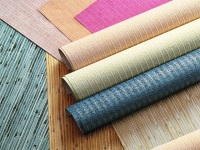
Experts are constantly working on the creation of new building and finishing materials that allow you to embody the luxurious and original solutions for the design of bathrooms, as well as have high performance qualities. Ordinary paper wallpaper is no longer relevant, now it's time for fiberglass wallpaper. They are very popular among ordinary buyers, because they have unique qualities. About all the advantages and disadvantages of glass wallpaper, as well as how to glue glass wallpaper, we will tell in this article.
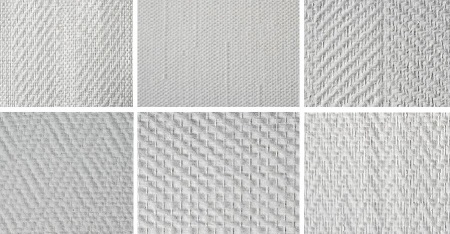
What is glass wallpaper?
Glass wallpaper is a kind of finishing materials, which is made on the basis of glass fiber. They undergo a special treatment with modified starch glue, which increases their strength and also allows them to retain their shape before being glued to the walls or ceiling.
Glass wallpaper is available in rolls. They are usually white in color, which becomes transparent when glued. Wallpaper is made from special glass based on silica sand, dolomite, soda and lime. Glass is heated to a temperature of 1200 degrees, after which it is pulled from the threads of varying thickness, then these threads are woven into fabric. The technology makes it possible to weave textured fabrics and dense fiberglass fleece - cobwebs.
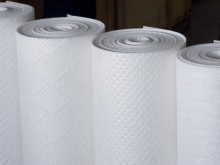
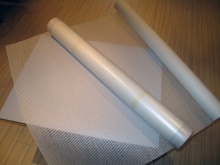
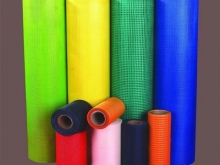
Pros
The main properties of glass wallpaper:
- durability - service life reaches 30 years;
- universality;
- environmental safety;
- resilience;
- non-combustibility;
- not afraid of temperature fluctuations;
- high level of moisture resistance;
- high strength;
- resistance to a variety of chemicals;
- not susceptible to rot, mold or mildew;
- the structure of the material is vapor permeable, which positively affects the microclimate of the bathroom;
- they do not collect dust and dirt, as they have antistatic effect;
- withstand up to 20 paint jobs;
- Are used as a base for further painting or painting.
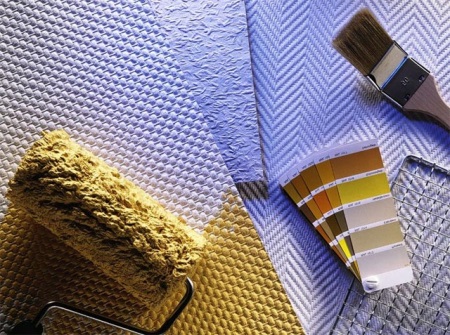
Types
All glass wallpaper, depending on the texture, is divided into:
- smooth - These include glass fleece and cobweb. This type of glass wallpaper is used to eliminate microcracks in the walls or ceiling. They are usually used in new buildings, as a result, a perfectly flat surface is created;
- embossed - have greater strength than smooth wallpaper. They are used in the final stage of finishing the walls or ceiling.
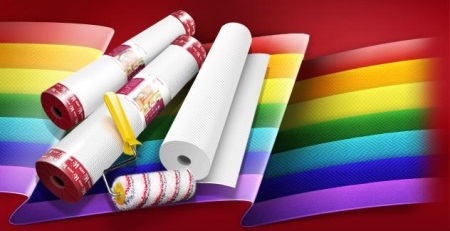
Peculiarities of gluing
Technology of pasting walls or the ceiling with glass wallpaper is largely the same as the pasting of conventional wallpaper.
But it is worth paying attention to some peculiarities:
- glue should be applied only to the surface of the walls, it is strictly forbidden to apply glue to the canvases;
- Glass wallpaper should be glued only back-to-back;
- You must leave an allowance of 10 centimeters to be able to dock the pattern on the canvases. After that, all the excess is cut off;
- The joint between the glass wallpaper can be horizontal or vertical;
- to paint the wallpaper is necessary twice, the time interval should be 12 hours;
- be sure to monitor the amount of glue or paint, because a thick layer will adversely affect the performance of the wallpaper;
- The temperature in the bathroom should be between 18 and 25 degrees and the humidity should not exceed 70 percent;
- It is necessary to beware of drafts after wallpapering.

It is not recommended to glue glass wallpaper on all the walls of the bathroom. It is not recommended to wallpaper the areas of the wall where the bathtub and washbasin are located. Although this material is resistant to moisture, but in constant contact with water, glass wallpaper can change its appearance and peel off.
All other bathroom walls can be decorated with glass wallpaper, which can be painted in any tone. To update the interior, you can repaint them in a different color or paint them in strips, combining several colors.
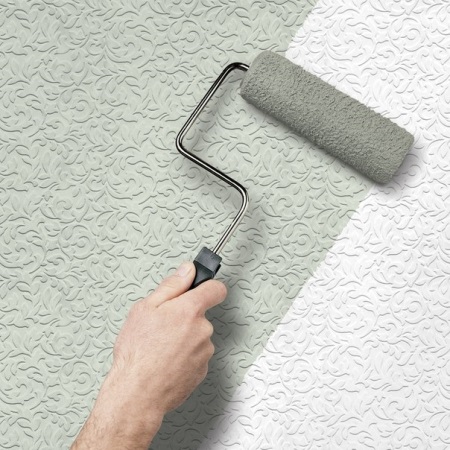
Glass wallpaper can be used for walls that are already painted with oil paint. But first it is necessary to make a preparation of the surface. It is necessary to purchase a special composition, which acts as a primer. The wall should be treated with the solution several times, with time intervals for good drying of each layer. Most bathrooms are often already painted with oil paint, so there is no need to remove it, just treat the surface responsibly and glass wallpaper will decorate the bathroom for many years.
Choose the right glue
Only properly chosen glue can guarantee reliable adhesion of the material to different surfaces. Well-known manufacturers of glue, which is used specifically for glass wallpaper, are the company Nortex, Oscar, Lacra and Master Pro.
The undeniable advantages of this type of glue include high safety for the environment and absolute environmental friendliness. The composition of the glue includes special additives to protect the wallpaper from mold and mildew.
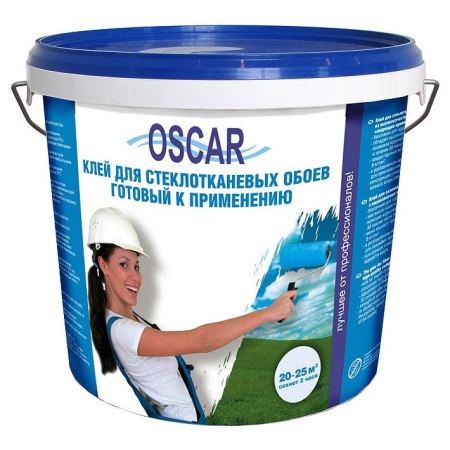
When buying glue consider that one liter is enough for pasting 5-6 square meters of wallpaper. The glue can be bought ready-made. Glue for glass wallpaper is also available in the form of dry powder, which is very easy to prepare according to the manufacturer's instructions. From 100 grams of powder you get three liters of ready-to-use glue. Powder is enough to pour cold water, stir well and after 10 minutes the glue is ready for use.
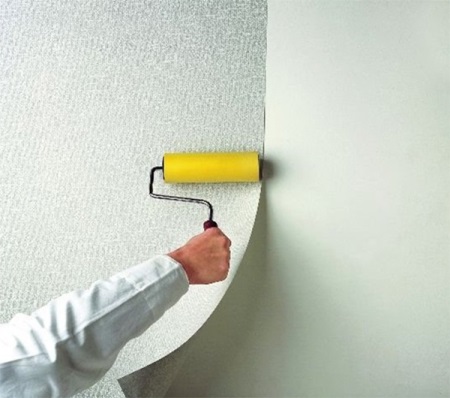
Wallpapering
- Before using glass wallpaper, it is necessary to inspect the walls. If the cracks are only 1 mm, then the alignment with additional materials can not be made, because glass wallpaper has excellent reinforcing properties. If the cracks are larger, then the alignment of the walls must be done with putty, then clean up with sandpaper and primer.
- Bathroom walls, where there is usually high humidity, should be treated with a special composition with antifungal properties.
- Prepare an adhesive composition. It may be in powder form or ready-made.
- It is necessary to find the front side of the cloth. It is usually located inside the roll. Some manufacturers of glass wallpaper use special markings in the form of gray or blue tape.
- Next, the cloth is cut, the size of which should be 5-10 centimeters more than the height of the wall, if there is a pattern. For cutting, you can use a box cutter or well-sharpened scissors.
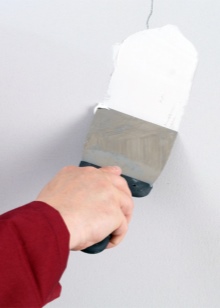
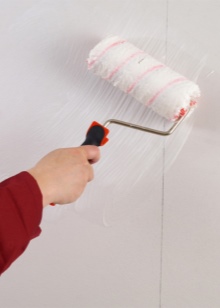
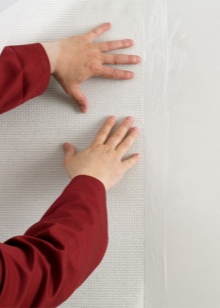
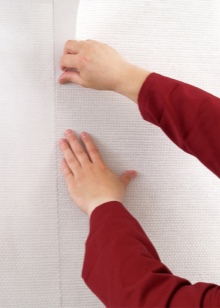
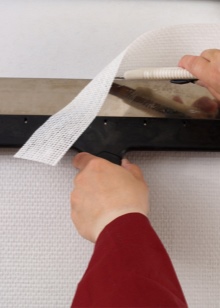
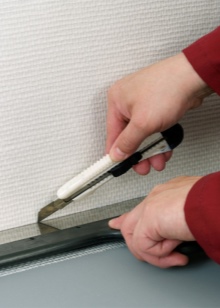
Gluing the glass wallpaper:
- It is necessary to apply the adhesive compound only on the area of the wall where the cloth will be glued. You can do this by using a special roller, so the glue will be evenly distributed, which will ensure an excellent result of pasting. If there are small areas of the wall without glue, the glass wallpaper will quickly begin to fall off the wall.
- Wallpapering is carried out by technology "butt joints". The first cloth is glued vertically, and then carefully smoothed with a plastic spatula or a special roller. The edge does not need to be pressed down hard, because it will join with the next fabric.
- Using a sharp knife, cut off the extra centimeters of material from the bottom and top. During this procedure, you should fix the glued cloth with a trowel.
- Then you can take on the next cloth. The process is repeated. When the second cloth will be glued to the wall, then it is necessary to pass carefully with a trowel or roller on the joint. Thus, glued all the walls.
- It is necessary to prime all the wallpaper on the walls with a special adhesive solution, which is made according to the instructions. This action will help to give the material rigidity, as well as reduce the consumption of paint.
- Painting the wallpaper is made after the glue dries completely, as well as the wallpaper must hold firmly on the wall. Therefore, the first painting takes place 24 hours after wallpapering, and the second no sooner than 12 hours after the first. Usually acrylic, latex or water-based paint is used to paint glass wallpaper. You can use a fur roller or sprayer to paint, which will make the process easier and faster. You can repaint the wallpaper up to 20 times in the future. If they are damaged by, for example, children or animals, staining will hide all the imperfections.

Wallpapering the ceiling
To simplify the process of pasting the ceiling with glass wallpaper, it is better to enlist the support of another person. One will be from below to feed the cloths, and the other, standing on a table or stepladder, already glue them to the ceiling. This approach will help speed up the process, because it will not be necessary to constantly slide down for another cloth.
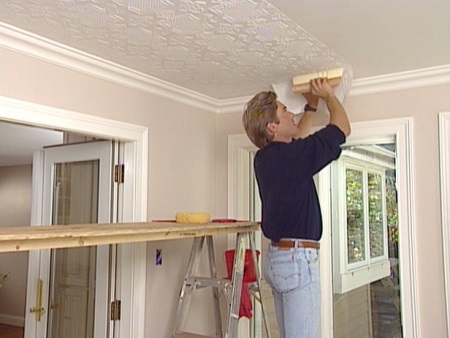
Procedure:
- First you need to stock up on a comfortable stepladder or table to have access to the ceiling.
- Before using glass wallpaper, you must first prepare the ceiling: level, apply putty and primer of deep penetration.
- The glass wallpaper is cut, leaving a margin of 5-10 centimeters to allow for the fitting of the texture.
- The process of pasting the ceiling should begin on the side opposite to the door.
- You can draw even lines on the ceiling, using a level, then the pasting of the canvases will be made correctly. These lines will help glue the first canvas.
- Using a roller, glue is applied only to the ceiling, because the canvas is already impregnated with starch, which has adhesive properties.
- Then the glass fleece is glued. It must be pressed firmly to the ceiling, and then, using a soft roller or plastic spatula, smooth out to eliminate air.
- The process of gluing is carried out only by butt joints.
- After gluing the glass wallpaper should cover the ceiling with a thick glue for strength and extra paint consumption at a later stage.
- Need to leave the ceiling until completely dry under normal room conditions.





We glued glass wallpaper on drywall) It turned out well, we will decorate other rooms the same way.